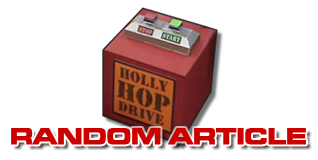 |
Sound Advice Mr Flibble talks sound effects, microphones and laughter with Sound Supervisor Keith Mayes. |

Andrew Ellard
After showing off his fancy new microphone, Mr Flibble whispered his first question into Andrew's shell-like ear, wanting to know how Keith got involved with SUPERVISING SOUND...
Television uses an enormous number of sound people, and when Jem [Whippey, Sound Supervisor on Red Dwarf VII and VIII] and I started, the place to go was the BBC. Nearly everyone I know in sound started out [doing sound] as a hobby - they played with tape machines at home, did stuff in the school play, played in bands. Most wanted to work in music. I wanted to go into music, but my wife's mother sent me this ad for the BBC. I applied to keep her happy! The mother-in-law didn't like this out of work bum living with her daughter! (Laughs)
Didn't you actually consult on the first series long before it was actually made?
The year before the first series, Jem and I... one of his best mates was Ed Bye. He came to see us with Rob and Doug one night and we went to the pub in Twickenham. They talked about this idea for a sit-com set in space, saying "We don't want it to be like an ordinary sit-com. We want it to be like Star Wars with laughs." We said it sounded great. "But we really want to beef the sound up," he said.

So they gave us the outline and we went into a recording studio for a couple of days, with a free hand and lots of synths, and just made weird noises. Nothing was shot, we just had rough ideas - there were going to be skutters, so we made motorbike noises. Lots of background [sounds]. Cat was going to speak like a cat, so we were going to use a vocoder to make him purr and growl. We just made loads of noises... I don't know who paid for it! (Laughs)
Red Dwarf then started... without you. How did you get involved again with Series III?
[Series I] was shot in Manchester, and then they came down and dubbed in London. Jem was a Gram Op at the time, and worked on it, but I didn't. The same with Series II. But Series III I dubbed, and for some reason we had time to introduce [more sound work]. There were more model shots, and also the show settled down and became more what I think Red Dwarf is.
We took a lot of the sounds we did originally. It still wasn't Star Wars, but it was starting to move that way - we still didn't have much time, and we had to get laughs in, which is a real pain in the arse. (Laughs) Laughs really screw things up.
Mr Flibble began playing with his new microphone, but gave up after his third electric shock. Red Dwarf is a BIG JOB - what makes it so difficult?
The big problem about Red Dwarf is there's a lot of awkward angles to shoot, effects - it always over-ran in post production. You could sit down and read [the script] and it would last 40 minutes, before you've done any action. Most things shoot a bit long, but it's much more difficult on Dwarf - there's huge sets, huge effects. It's a nightmare. Red Dwarf got three days to dub an episode. For a sit-com to get a three-day dub is unheard of - for a sit-com you're expected to do at least one and probably two a day.
What was the nature of the sound department's relationship with Rob Grant and Doug Naylor?
When it came to the dub, they'd leave us alone in the dub and we kind of knew what they wanted, and then they'd come in... and not like it! (Laughs) We used to argue about laughs more than anything else. You have to put in a lot of laughs because it's shot so fragmented-ly. There were always arguments about whether to leave laughs on knob gags - if you don't want laughs on them, don't write them! (Laughs)
Rob was always more into the toys, the technical side. Doug was more the comedy writer, Rob was the sci-fi. The last time I saw Doug was on a beach in the Caribbean, believe it or not! "What're you doing here?!" "I'm having a holiday." "Me too." (Laughs)
There was one series (V) where the director [Juliet May] only lasted about a week and then Grant Naylor took over. We all knew Juliet well, and that was very strange. Juliet's a lovely director, really good, does a lot of dramas now. She was making it look really pretty - but was spending a long time doing that. Even Rob and Doug knew, 'We've got to get in close on the comedy, because it's already going to be miles too long!'
Talk us through THE PROCESS, the layers of sound on an episode of Red Dwarf...
What we tried to do was have every location have its own background, base noise. When it was on Red Dwarf, and even when it was on Starbug, anything that was in the bowels of the ship, we decided, would be sort of organic. There's lots of clunking, water dripping - not high-tech.

Within the series - and definitely within a show - we tried [to be consistent], but we weren't rigid. They moved, they evolved. All those spaceship noises were jet fighters slowed down, speeded up, added effects. Any effect that came off a disc, we refused to play straight. It would always be put through a box.
We didn't over-do the stereo - we did with the backgrounds, but not the effects - because people were still listening in mono and it can really bugger up the mono. Music, if it had got there in time, we'd lay in - but just to have a listen to, because Doug was going to change it. (Laughs)
Then you'd go through to see if there were any spot effects. So if he's got a bazookoid, obviously there's a ka-dunk. I don't know who decided this, but everything was going to make a noise. Every button was going to go bleep. It was a pain to find enough button noises! Then all the dialogue had to be sorted out, the editing of that - it all has to match.
Are you involved with collecting the dialogue?
If I can do that, I prefer to, because it's much easier knowing what I can then do in post. So I try to follow things through - even the single-camera locations. It's nearly all boom [microphones].
Have you had to hide mikes on the set?
Loads of times! All over the place! This goes for any show - as soon as you put a fixed mike in place, as soon as they move you're in trouble. I did Drop the Dead Donkey, which had nine principal actors, a huge composite set and a ceiling piece. Pick-up on the set was a nightmare. We had to have fixed mikes there, but it means they have to hit, exactly, their marks - and this might be in a ten-minute scene.
In Starbug, sat at their desk, you've got much more chance of picking it up. But, still, if he moves you're in trouble - whereas with a boom mike, the operator spots it and moves with him.
What are your feelings on ADR? (Automatic Dialogue Replacement, where actors have to re-record their lines in synch with their original performance.)
ADR is to be avoided at all possible costs. I hate it. You can't get the acoustics right, it doesn't match anything else. We did odd lines, but on most TV stuff it isn't an option - you have to keep the artists on contract for longer. Plus there's nearly always a way around it.

One time I do remember doing it [was Dimension Jump]. Starbug had crashed into a sea, and we had the wind machines with VW engines blowing. I did have radio mikes on them, as a guide, but that was always intended to be dubbed - there was no way they were going to pick up with the wind blowing.
And then you have to get in the laughs...
We do the laugh track last. That's a real pain, because all the timing for the laughs has gone - you've edited everything really tight.
Mr Flibble was still bragging about the size of his microphone, but when Keith produced his big furry boom he finally shut his penguin mouth. Finally, of the Red Dwarf jobs, what's been the most FUN STUFF to do?
There were lots of reports in the technical papers about how Star Wars had made their own effects. One of my favourite episodes is Polymorph, with the heat-seeking missiles - the scene where they're going down the corridor where it changes from the missile's point of view to outside to going round the corner... which took bloody ages.
So there's background noise in the cargo hold, the sound of the missiles, explosions and things - but what we really wanted was the sound, when they went round corners, of that movement. And we'd just read about the lightsabers, how they did that, so we nicked their idea with our own sounds.
They had a rifle-mike plugged into the [sound] desk, put in a noise, then put it out through a speaker and [pointed the microphone at it]. They fed the speaker back with the noise, and as you move the microphone [away] it fades. It's controlled feedback!
The real fun stuff was the monster noises, and they were really made up from scratch - that's people going 'uuurrrwghwhw'. Mike Agnew [Production Manager]'s voice is on everything. We did lots of weird things. For Polymorph we had lots of Swarfega - Swarfega was really popular! We used to go into the studio and just hit things. (Laughs)
Mr Flibble enjoyed talking to Keith Mayes, and now that it's over... Mr Flibble is very cross.
Still in a sound mood? Check out Mr Flibble Talks to... Jem Whippey














